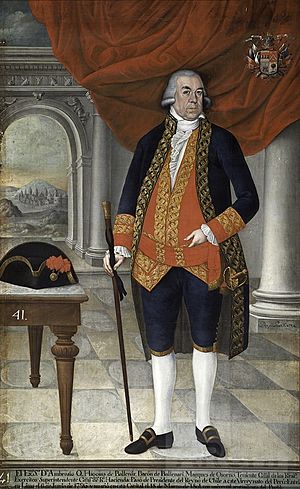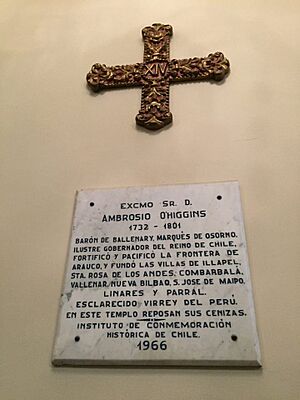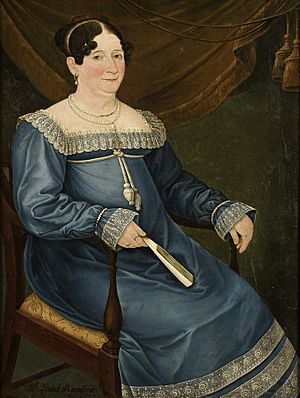Ambrosio O'Higgins, 1st Marquess of Osorno facts for kids
Quick facts for kids
The Most Excellent
The Marquess of Osorno
|
|
|---|---|
 |
|
| 36th Viceroy of Peru | |
| In office 24 July 1796 – 18 March 1801 |
|
| Monarch | Charles IV |
| Prime Minister | Manuel de Godoy |
| Preceded by | Francisco Gil de Taboada |
| Succeeded by | Manuel Arredondo |
| Royal Governor of Chile | |
| In office May 1788 – 16 May 1796 |
|
| Monarch | Charles IV |
| Prime Minister | The Count of Floridablanca |
| Preceded by | Ambrosio de Benavides |
| Succeeded by | José de Rezabal |
| Personal details | |
| Born | c. 1720 Ballynary, County Sligo, Ireland |
| Died | 19 March 1801 (aged 80–81) Lima, Peru |
| Children | Bernardo O'Higgins |
Ambrosio O'Higgins (born around 1720 – died March 19, 1801) was an important Irish-Spanish leader. He worked for the Spanish Empire in South America. He was the military governor of Chile from 1788 to 1796. Later, he became the viceroy of Peru from 1796 to 1801. His son, Bernardo O'Higgins, became a famous leader who helped Chile gain its independence.
Contents
Early Life and Travels
Ambrosio O'Higgins was born in Ballynary, County Sligo, Ireland. His family, the O'Higgins, had lost their land earlier. They became tenant farmers, meaning they rented land from others.
In 1751, Ambrosio moved to Cádiz, Spain, where he worked in business. In 1756, he moved to Spanish America. He traveled a lot, working as a trader in places like Venezuela, New Granada, and Peru. He later moved to the La Plata Colony, which is now Argentina.
While there, he suggested building an easier road over the Andes mountains to connect Chile and Mendoza. His idea was accepted, and he helped to manage this big project.
Working in Chile
Around 1760, Ambrosio O'Higgins joined the Spanish Imperial Service. He started as a draughtsman and then became an engineer. He was in charge of setting up a reliable postal service between La Plata and Chile.
During a tough winter journey over the Andes in 1763–64, he thought of building a series of strong shelters. By 1766, thanks to his hard work, Chile had postal service with Argentina all year round. Before this, it was often cut off for months in winter. These mountain huts are known as Casuchas del Rey.
In 1764, another Irish engineer, John Garland, convinced him to move to Chile. Ambrosio started as a junior officer in the Spanish army.
In 1770, the Governor of Chile made him a captain. He led cavalry soldiers against the Araucanian Indians. He won battles and helped Spain get back land. He also founded a fort called San Carlos. He was known for being kind and fair to the Native Americans.
He quickly moved up in the army. In 1777, he became a colonel. Then he became a brigadier. In 1786, he was put in charge of Concepción. In 1788, King Charles III of Spain made him the 1st Barón de Ballinar. He was also promoted to major-general. Soon after, he became the Governor of Chile.
Governor of Chile
As governor, Ambrosio O'Higgins worked very hard. Chile was a difficult and distant Spanish colony. He oversaw the building of a main road between Santiago and the port of Valparaíso. Parts of this road are still used today.
He also continued building the Palacio de la Moneda in Santiago. He improved other roads and built strong walls along the Mapocho river. This stopped the river from flooding Santiago often.
He founded many new cities, including:
- San Ambrosio de Ballenary (now Vallenar) in 1789
- Villa de San Francisco de Borja de Combarbalá (now Combarbalá) in 1789
- Villa San Rafael de Rozas (now Illapel) in 1789
- Santa Rosa de los Andes (now Los Andes) in 1791
- San José de Maipo in 1792
- Nueva Bilbao (now Constitución) in 1794
- Villa de San Ambrosio de Linares (now Linares) in 1794
- Villa Reina Luisa del Parral (now Parral) in 1795
O'Higgins focused on making Chile's economy stronger. He improved trade with other Spanish colonies. He also ended the encomienda system. This system forced native people to work the land for the Spanish crown. This change was made official by a royal order in 1791. He became a lieutenant-general in 1794.
He also encouraged growing rice and sugar cane in Chile. However, rice farming in Chile only really started much later, around 1920.
Malaspina Expedition
In 1787, a ship called the Astrea visited Talcahuano, a port in Chile. Its captain was Alessandro Malaspina. Six months before, O'Higgins had suggested that Spain should send its own exploration trips to the Pacific Ocean. He thought this after the French Lapérouse expedition visited Concepcion in 1786.
O'Higgins likely talked about this with Malaspina. Later, Malaspina and another officer proposed an expedition, using O'Higgins's ideas. The Spanish government quickly agreed. They were also worried about Russia planning an expedition to the North Pacific.
Huilliche Uprising of 1792
In 1784, there was a plan to build a road through Huilliche territory. This worried the Huilliche people. They formed alliances and asked the Governor of Valdivia for help.
In 1789, the Treaty of Río Bueno was signed. This treaty helped prevent a military invasion. It also allowed Spaniards to settle north of the Bueno River. The Huilliche people also agreed to let Spaniards rebuild Osorno, a city that had been abandoned. In 1792, O'Higgins rebuilt Osorno. For this, King Charles IV made him the 1st Marquess of Osorno in 1796.
However, some Spanish settlers treated the Huilliche badly. This made several Huilliche chiefs change their minds. They formed an alliance and started the Huilliche Rebellion of 1792. They attacked farms and missions. Their goal was to attack Valdivia.
The Spanish leaders responded strongly. Governor O'Higgins sent Captain Tomás de Figueroa to stop the rebellion. Figueroa burned Huilliche houses and crops. He also arrested many Huilliche men.
After this, the Spanish decided to make a new treaty. A meeting was held in Las Canoas in 1793. In this new treaty, Spaniards gained the right to build farms south of the Bueno River.
Parliaments of 1793
In 1793, another important meeting was held in Negrete. This meeting was to confirm an older treaty from 1783. The King of Spain was recognized as the ruler of the Araucanía region. However, the land itself was kept for the Mapuche people. This meant the King of Spain had official power, but the Mapuche-controlled lands were largely independent.
The treaty celebration lasted several days. There were many feasts with food and drink. This treaty was very expensive, costing a lot of money for Chile's treasury.
Viceroy of Peru
In 1796, O'Higgins was appointed Viceroy of Peru. This was a very important job, as Peru was one of the richest Spanish colonies. It included what is now Peru and Chile.
When Britain and Spain went to war in 1797, O'Higgins worked to protect the coast. He made the forts stronger in Callao and built a new fort in Pisco. He also planned and built a new road from Lima to Callao. During his time as viceroy, he focused mainly on improving roads and communication.
He passed away suddenly in 1801 after a short illness. He was buried in the Iglesia de San Pablo in Lima, which is now Iglesia de San Pedro.
Family Background
Ambrosio O'Higgins came from the O'Higgins family in County Sligo, Ireland. His family were Gaelic nobles who once owned a lot of land. However, due to changes in Ireland, their lands became smaller.
His family later moved to Summerhill in County Meath. There, they became tenant farmers. Some of his family's descendants still live in Summerhill today.
His Son, Bernardo O'Higgins
In 1777, Ambrosio O'Higgins met Isabel Riquelme. She gave birth to his only son, Bernardo, in August 1778. Bernardo O'Higgins later became a key leader in Chile's fight for independence from Spain.
Even though Ambrosio O'Higgins never officially recognized Bernardo as his son, he paid for his education in England. He also left Bernardo some of his property in Peru and Chile.
Bernardo O'Higgins led Chile as its Supreme Director from 1818 to 1823. He later had to leave Chile and went to live in Peru with his mother, sister, and son.
Legacy
Several places in the Americas were named after Ambrosio O'Higgins's birthplace. For example, Vallenar in Chile was originally called San Ambrosio de Ballenary. There is also Vallenar Bay in Alaska.
See also
 In Spanish: Ambrosio O'Higgins para niños
In Spanish: Ambrosio O'Higgins para niños
- Juan Albano Pereira Márquez
- Lebian
Images for kids





